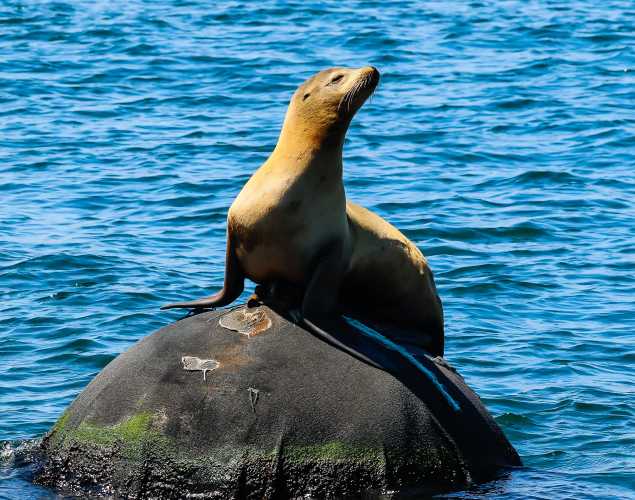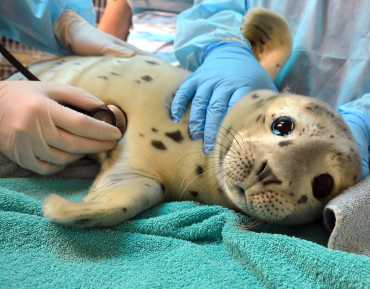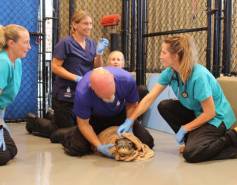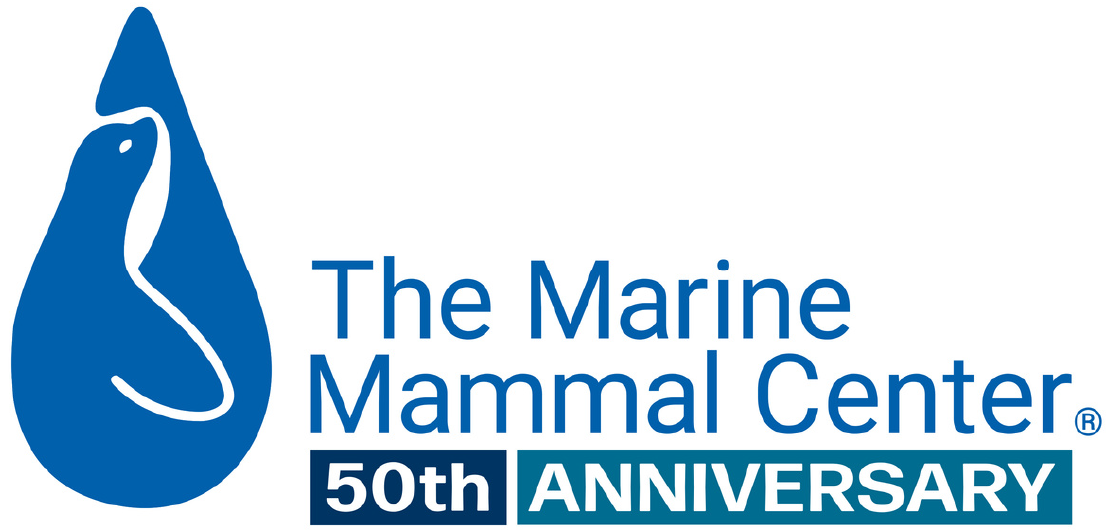
More Than a Third of California Sea Lions Rescued This Year Affected By Toxic Algae Bloom
- Domoic acid
Causing neurological problems such as seizures and disorientation, domoic acid toxicity can be deadly, and this year more than a third of the California sea lions we’ve rescued have been affected.
When Jaisy was spotted on Morro Strand State Beach in San Luis Obispo County, the adult female California sea lion was disoriented, walking in circles and continuously moving her head from side to side in a rolling, rhythmic motion. Our trained volunteers knew immediately that she needed help—she was exhibiting classic signs of domoic acid toxicity.
Domoic acid is a biotoxin produced by harmful algal blooms of the microscopic diatom Pseudonitzchia australis. The toxin accumulates in small fish, like sardines and anchovies, which are then eaten by sea lions in large amounts.
Exposure to the domoic acid biotoxin affects the brain, causing lethargy, disorientation, seizures and, eventually, death.
On August 1, The Marine Mammal Center’s rescue volunteers brought Jaisy to our San Luis Obispo triage facility where she joined a number of other California sea lions—all suffering from similar symptoms.
Jaisy was rescued during the height of a toxic algae bloom in the Monterey Bay area, the second this year. She is just one of more than 220 California sea lions we’ve rescued this year due to the effects of this toxin—accounting for more than 36 percent of the sea lions we’ve rescued so far in 2014.
That’s more than twice what we see in a typical year, when about 15 to 16 percent of our sea lions are rescued due to domoic acid toxicity. But this year has been anything but typical. We rescued a record number of patients early in the year, and part of that rush of patients was due to a toxic algae bloom in April.
Luckily, Jaisy had only recently been exposed to the biotoxin, giving her an acute case of domoic acid toxicity. We were able to flush the toxin from her system with fluids and prevent her from seizing by giving her phenobarbitol, an anti-seizure medication that is also used in humans.
In 1998, The Marine Mammal Center diagnosed the first case of domoic acid toxicosis in marine mammals, and we’ve been studying the condition ever since. We’ve learned a lot about how this biotoxin affects sea lions and how to treat it in animals like Jaisy who have had minimal exposure. And we know that the toxin affects humans as well, causing a condition called amnesiac shellfish poisoning.
But what we don’t know is why these domoic acid outbreaks occur. We’re doing our part to learn as much as we can about this toxin and its effects. By rescuing sea lions affected by domoic acid, we not only save their lives, but we are also able to help identify changes to the health of the ocean. Any time we rescue more than one sea lion suspected of domoic acid toxicity from an area, we alert public health officials so that they can help ensure humans are safe from contaminated seafood.
Unfortunately, there’s no one to tell sea lions not to eat fish from an area with a toxic algae bloom, which is why animals like Jaisy end up needing our help.
After about 10 days in our care, Jaisy seemed to be improving, but before she could be cleared for release, she had to pass her final neurological assessment. Over a period of several days, Jaisy was closely monitored for healthy neurological behavior, such as alertness, the ability to move quickly on all four flippers and a natural instinct to avoid or be aggressive toward humans.
Every two days, she was given a “neuro score” based on any noticeable signs of neurological damage; as in golf, a low score is best. On August 10, she earned a 17; two days later, a 13; then a 7; and finally a 6. Two scores under 10 and a descending trend meant Jaisy was cleared to return to the wild.
On August 19, she and three other sea lions successfully treated for domoic acid toxicity were released at Chimney Rock in Point Reyes National Seashore. Jaisy headed straight for the waves without a second look, swimming out into the great unknown.
Yes, I want to save a life!

Yes, I want to save a life!
You’ll be giving sick and injured animals the best possible care at the Center’s state-of-the-art hospital. With your gift today, you are giving a patient a second chance at life in the wild.
See Our Latest News
{"image":"\/Animals\/Patients\/Hawaiian monk seals\/2025\/cropped-images\/d-ru28release-exam-at-ke-kai-ola111025photo-by-giancarlo-rulli-c-the-marine-mammal-center-noaa-permit-24359-0-0-1270-992-1764620886.jpg","alt":"","title":"Bird Flu Vaccine Trial Offers Hope for Protecting Hawaiian Monk Seals","link_url":"https:\/\/www.marinemammalcenter.org\/news\/bird-flu-vaccine-trial-may-offer-hope-for-protecting-hawaiian-monk-seals","label":"News Update","date":"2025-12-01 08:13:00"}

Bird Flu Vaccine Trial Offers Hope for Protecting Hawaiian Monk Seals
December 1, 2025
Read More{"image":"\/Animals\/Patients\/Hawaiian monk seals\/2021\/hms-pp08-by-sheila-latta-c-the-marine-mammal-center-noaa-permit-18786.jpg","alt":"Hawaiian monk seal","title":"The New York Times: Inside the Bird-Flu Vaccine Trial for Monk Seals","link_url":"https:\/\/www.marinemammalcenter.org\/news\/the-new-york-times-inside-the-bird-flu-vaccine-trial-for-monk-seals","label":"In the News","date":"2025-12-01 01:00:00"}

The New York Times: Inside the Bird-Flu Vaccine Trial for Monk Seals
December 1, 2025
Read More{"image":"\/Animals\/Wild\/Sea otter\/so-wild-morro-bayphoto-c-brian-simuro-20.jpeg","alt":"Sea otter and pup","title":"Watch a Sea Otter Pup Reunite With Its Mother","link_url":"https:\/\/www.marinemammalcenter.org\/news\/watch-sea-otter-pup-reunite-with-its-mother","label":"News Update","date":"2025-11-14 10:35:41"}

{"image":"\/Animals\/Wild\/Sea otter\/sea-otter-photo-c-brian-simuro.jpeg","alt":"Sea otter","title":"AP News: Baby sea otter is reunited with mother in central California after dramatic rescue","link_url":"https:\/\/www.marinemammalcenter.org\/news\/ap-news-baby-sea-otter-is-reunited-with-mother-in-central-california-after-dramatic-rescue","label":"In the News","date":"2025-11-14 09:46:34"}

AP News: Baby sea otter is reunited with mother in central California after dramatic rescue
November 14, 2025
Read More